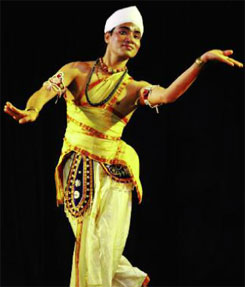 For Bhabananda Barbayan, dance is not just passion. As he continues learning to excel in the age-old Sattriya nritya, he finds it’s an act of spiritualism, a mission, a thought process, and a journey into discovering the self
For Bhabananda Barbayan, dance is not just passion. As he continues learning to excel in the age-old Sattriya nritya, he finds it’s an act of spiritualism, a mission, a thought process, and a journey into discovering the self
It’s breathing,” he tells me, when I ask 38-year-old Bhabananda Barbayan about what dance means to him. Many of you may not have heard of this young man. Sattriya nritya, which he has devoted his life to promoting, is a dance form that needs to be recognised far more in the public domain than it is, at present. Although it is among the eight principal classical Indian dance traditions — it was recognised in 2000 as a classical dance by Sangeet Natak Akademi – Sattriya nritya, agrees Hazarika, still has a lot of potential in terms of reaching out to people at large.
Before we talk about the man, let’s pause to understand what this dance form is all about. What makes it so ethereal when you’re observing the dance as a viewer? What defines its glory? How does it serve to enrich the viewers who watch this dance spellbound, in rapt attention? Hazarika, exponent of this richly layered dance form, has the answers. “The dance,” he says, “is spiritual, and that’s a reason why viewers watching it are enchanted with it.” To understand how elegantly this dance form is immersed in mysticism and charm, it’s worthwhile to know the genesis of this dance form.
It is, in fact, a living tradition — with dance being an integral part of the Sattriya tradition — since the 15th century, when it was introduced by Srimanta Sankardeva in Assam. Although performed by celibate male monks (a tradition that continues till date) initially, Sattriya nritya is now performed by both male and female artists. Begun as part of the bhakti tradition, in which the unique dance and its accompanying music offers respect to Krishna by showcasing mythological tales and episodes, Sattriya dance has remained a living tradition in Assam’s Vaishnava monasteries, known as sattras, for over 500 years now.
It’s not an easy life either, especially when you realise how painstakingly exponents of this dance form have learnt it.
For Hazarika, who has travelled all over the world, to France, Britain, Portugal, Switzerland, China and Malaysia, among other destinations, for lectures, seminars, dance-demos, festivals and events, promoting this dance form is his lifelong mission.
When he was four years old, Hazarika’s parents sent him away to Uttar Kamalabari Sattra, one of the prominent Vaishnavite monasteries of Assam. There, for the next decade-and-a-half or so, he would learn to live a rigorous life — few hours of sleep, taking care of the monastery complex, cooking, farming, looking after the cattle, studying, dancing… Wasn’t it tough, to give up the idyllic childhood days of growing up with his parents and getting embroiled in such a tough routine at such an early age? “I was the tenth generation in my family who was sent to the monastery as part of a continuing tradition to learn the Sattra way of life. I wasn’t isolated in any way. I kept visiting my parents regularly, I made friends, I had completed my formal studies,” he explains, adding, “It was a way of life. It taught me discipline and gave me a routine I still follow.”
Hazarika has post-graduate degrees in geography and Assamese literature. His PhD in dance, which he completed from Rabindra Bharati University, Kolkata, not surprisingly, was on the rhythmic patterns of Sattriya. And although he could have made a choice of not pursuing the dance form professionally – given his educational accomplishments – Hazarika decided to pursue dance fulltime. “This dance form is my life. It has allowed me to develop my personality – physically, mentally, and emotionally. Sattriya dance has allowed me to grow and develop into the person that I am today,” he says.
There are challenges, he reckons. In the earlier days, this dance form was only performed in the confines of the sattra (monastery) simply because it was an offering, a prayer, a purifying of the senses through dance. Later, however, for it to reach out, Sattriya dancers started performing in prosceniums where the time was restricted. The spirit of the dance, however, couldn’t be compromised on and that’s why exponents such Hazarika have to really struggle to ensure the dance pieces are perfected and thoroughly convey the message of spirituality, of bhakti.
To be sure, some of Hazarika’s dance dramas are changing their complexion and fitting many more legendary tales of bravery from Assam.
“I do a lot of research before starting any production,” explains this dance guru who is packing his bags to go to Assam to teach students (he divides his time between Delhi and Assam, interspersing it further with his travels abroad) and also work on his forthcoming production. Hazarika will be scouring the traditional texts, closely examining historical and mythological tales, and finding more literature from sources on Srimanta Sankardeva and Krishna bhakti for his next production.
“Dance,” Hazarika says pensively, “has taught me to live responsibly.” He corrects anyone who suggests how dance is such an important part of his life. “No, it’s not a part. It is my life,” he adds. “It has taught me how to respect everyone, first and foremost my art. It has taught me how to move forward in my life, how to face difficulties, how to overcome them… Yes, I am because of what I have learnt all my life. And all my life, I have devoted to growing this art form and bringing it to people,” he says.
